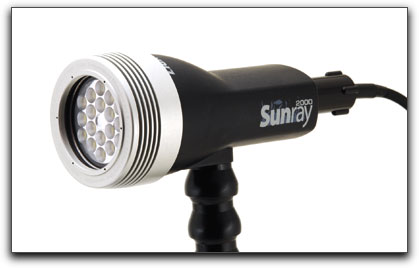

July 28, 2008
Light and Motion Sunray 2000 Video Lights

http://uwimaging.com
"Sunray 1000" $2,599.00 - "Sunray 2000" $3,799.00
Review by Steve Douglas
Filming underwater has most of the very same requirements as does shooting topside. Composition and framing is equally as important and lighting can be as tricky as it can sometimes be when shooting either in the studio or under the sun. Unfortunately, when shooting underwater there can be even more issues to contend with. As we dive deeper into the oceans colors dissipate. Once we drop below the first atmosphere (33 ft) the reds and yellows disappear, this is followed by the blues bidding adieu until all we have left is an indistinct gray/green. However, the underwater filmer can bring back all the colors easily enough by the use of underwater lights. Early diving lights were usually halogen lights and while this certainly improved things, their low color temperature, usually at around 3400k failed to bring back all the colors there were to be seen. These were followed in the industry by HID lights with color temperatures between 5900 and 6200k which certainly improved things. However, when used filming at night, they often added a bluish tinge to video. I frequently would travel overseas with 2 sets of lights, a pair of halogens to use during the evening shoots for the warmth they brought to a shoot and a set of HID lights for daytime usage. This leads us to a new generation of video lights for underwater use.
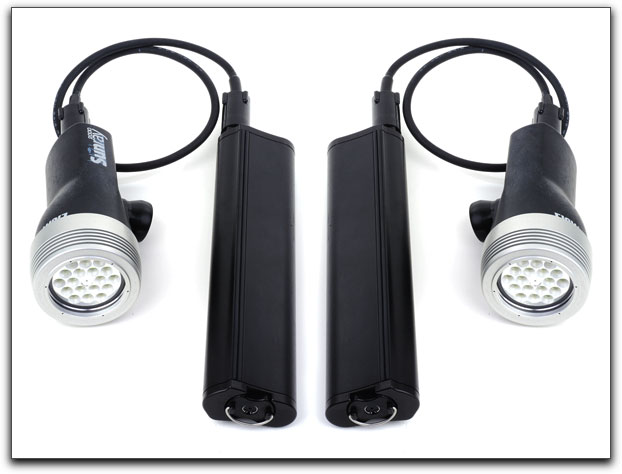
The Light & Motion Sunray 2000s here shown with the water tight battery pods which connect to the camcorder housing.
Light and Motion truly has lit the way with their new 2000 Video Lights. Previously, concerns with most video lights have focused upon the short burn times, the slow build to full power of HID lights, and uneven light spread and hotspots of many lights used for filming. Light and Motion has dispelled the need for any of these concerns with a timely offering of both the Sun Ray 1000 and 2000 Lights. The Sunray 2000 lights produce 2000 lumens per light at the high setting, 1000 lumens at the medium and 500 lumens at the low setting coupled with a 6500k color temperature. That is a lot of clean light, more than double the light output of their 22w HID lights which produced 950 lumins.
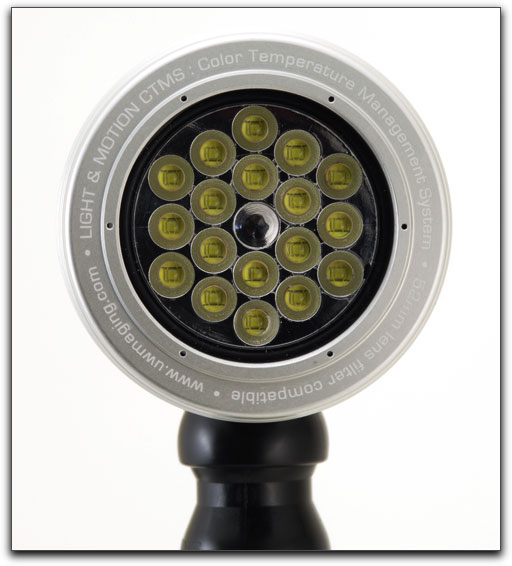
Each light head contains a 50,000 hour bulb life with its 18-LED array, a micro-peened reflector providing a very even beam, and only a 1.5 hour recharge time. That is a major improvement over previous models. The Sunray 2000s can be either handle operated using the wireless infrared control on Light & Motion housings, or can be powered via the battery pod when using them with other manufacturer's housings. In addition, each light, made from marine grade aluminum, is impact resistant with solid state construction, and has a 300ft depth rating.
No warm up time is necessary as the Sunray 2000s' have an instant on/off control, wet connect capability and a wireless infrared control when used with Light & Motion housings. Never the less, the Sunray 2000 lights are fully compatible with other manufacturer housings as well. I found each light's 3 separate output settings very useful when filming. For wide-angle clip captures I used the full power setting, and for close ups, either the medium or low settings did the job well. For water with lots of particulate, the low power settings greatly helped reduce the particulate problems. On all settings, I found the light spread to be devoid of hot spots and little adjustment of the light head position was necessary once set. Burn times are excellent with a full 65 minutes at the high settings up to 260 minutes using the low output off a charged battery. While there is a low battery warning, it never came up despite using the lights for 2 extended dives on a single charge in the very cold waters of Alaska. This is significant as cold water adversely affects the life of almost all battery types.
While I did not test the Sunray 1000s which sell for $2599, these lights feature the same technology as their big brother, the Sunray 2000s. The 1000s model also has a 3 position output setting control which the user can adjust from 1000 lumins at the high setting, 500 at the medium and 250lm at the low settings with burn rates between 85 and 340 minutes.
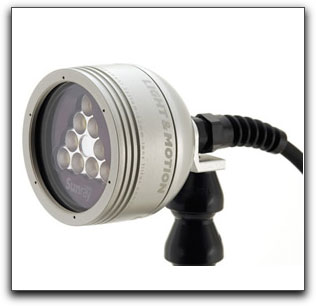
The Light & Motion Sunray 1000s offer the same quality
as the Sunray 2000s for the budget minded underwater videographer.
When I first saw the Light & Motion Sunray 2000 underwater lights in their proto type stage, I recall salivating at the thought of getting to use them one day. Now that I have, my bottom line is that it was well worth the wait. These were just great to use and their light weight and small size made packing them less of a chore.
With so many professional film-makers already having gone to LED lights in their studios, it is no wonder that Light & Motion has led the way for the underwater videographer. Let there be light!
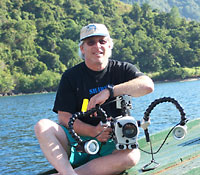 Steve Douglas is a certified Apple Pro for Final Cut Pro 6 and underwater videographer. A winner of the 1999 Pacific Coast Underwater Film Competition, 2003 IVIE competition, 2004 Los Angeles Underwater Photographic competition, and the prestigious 2005 International Beneath the Sea Film Competition, where he also won the Stan Waterman Award for Excellence in Underwater Videography and 'Diver of the Year', Steve was a safety diver on the feature film "The Deep Blue Sea", contributed footage to the Seaworld Park's Atlantis production, the History channel's MegaDisaster show and other networks. Steve is one of the founding organizers of the San Diego UnderSea Film Exhibition and leads both underwater filming expeditions and African safaris with upcoming excursions to Indonesia and the Coco Islands, Costa Rica in 2008, Kenyan safari in Africa and the Red Sea for 2009, and Truk Lagoon in Micronesia for 2010. Feel free to contact him if you are interested in joining Steve on any of these exciting trips. www.worldfilmsandtravel.com
Steve Douglas is a certified Apple Pro for Final Cut Pro 6 and underwater videographer. A winner of the 1999 Pacific Coast Underwater Film Competition, 2003 IVIE competition, 2004 Los Angeles Underwater Photographic competition, and the prestigious 2005 International Beneath the Sea Film Competition, where he also won the Stan Waterman Award for Excellence in Underwater Videography and 'Diver of the Year', Steve was a safety diver on the feature film "The Deep Blue Sea", contributed footage to the Seaworld Park's Atlantis production, the History channel's MegaDisaster show and other networks. Steve is one of the founding organizers of the San Diego UnderSea Film Exhibition and leads both underwater filming expeditions and African safaris with upcoming excursions to Indonesia and the Coco Islands, Costa Rica in 2008, Kenyan safari in Africa and the Red Sea for 2009, and Truk Lagoon in Micronesia for 2010. Feel free to contact him if you are interested in joining Steve on any of these exciting trips. www.worldfilmsandtravel.com
[Top]
copyright © Steve Douglas 2008
© 2000 -2008 Ken Stone. All rights reserved. Apple, the Apple logo, Final
Cut Pro, Macintosh and Power Mac
are either registered trademarks or trademarks of Apple. Other
company and product names may be trademarks of their respective
owners.
All screen captures, images, and textual references are the property and trademark of their creators/owners/publishers.








 Steve Douglas is a certified Apple Pro for Final Cut Pro 6 and underwater videographer. A winner of the 1999 Pacific Coast Underwater Film Competition, 2003 IVIE competition, 2004 Los Angeles Underwater Photographic competition, and the prestigious 2005 International Beneath the Sea Film Competition, where he also won the Stan Waterman Award for Excellence in Underwater Videography and 'Diver of the Year', Steve was a safety diver on the feature film "The Deep Blue Sea", contributed footage to the Seaworld Park's Atlantis production, the History channel's MegaDisaster show and other networks. Steve is one of the founding organizers of the San Diego UnderSea Film Exhibition and leads both underwater filming expeditions and African safaris with upcoming excursions to Indonesia and the Coco Islands, Costa Rica in 2008, Kenyan safari in Africa and the Red Sea for 2009, and Truk Lagoon in Micronesia for 2010. Feel free to contact him if you are interested in joining Steve on any of these exciting trips.
Steve Douglas is a certified Apple Pro for Final Cut Pro 6 and underwater videographer. A winner of the 1999 Pacific Coast Underwater Film Competition, 2003 IVIE competition, 2004 Los Angeles Underwater Photographic competition, and the prestigious 2005 International Beneath the Sea Film Competition, where he also won the Stan Waterman Award for Excellence in Underwater Videography and 'Diver of the Year', Steve was a safety diver on the feature film "The Deep Blue Sea", contributed footage to the Seaworld Park's Atlantis production, the History channel's MegaDisaster show and other networks. Steve is one of the founding organizers of the San Diego UnderSea Film Exhibition and leads both underwater filming expeditions and African safaris with upcoming excursions to Indonesia and the Coco Islands, Costa Rica in 2008, Kenyan safari in Africa and the Red Sea for 2009, and Truk Lagoon in Micronesia for 2010. Feel free to contact him if you are interested in joining Steve on any of these exciting trips.